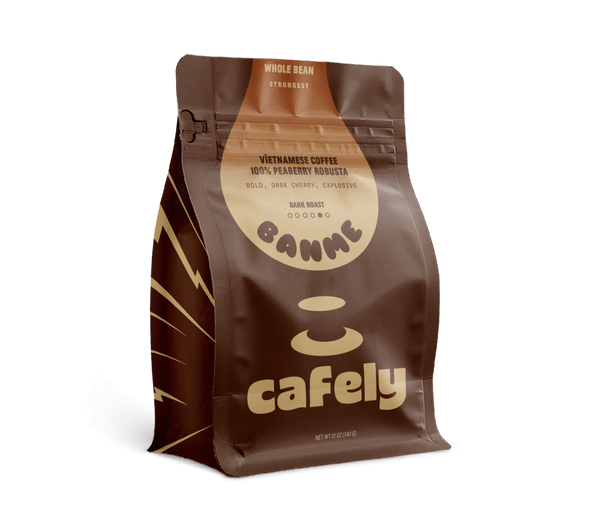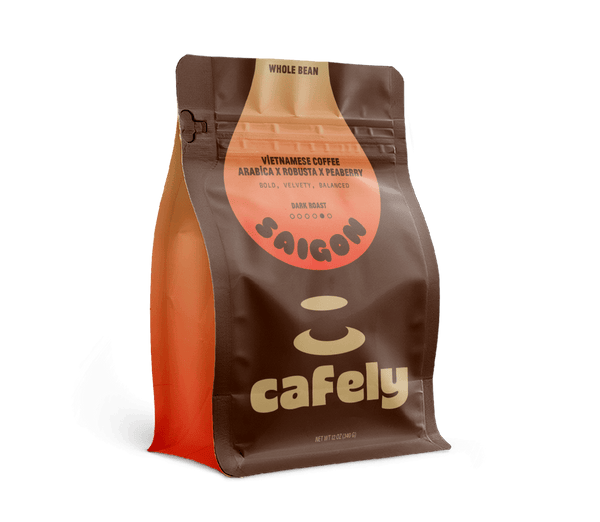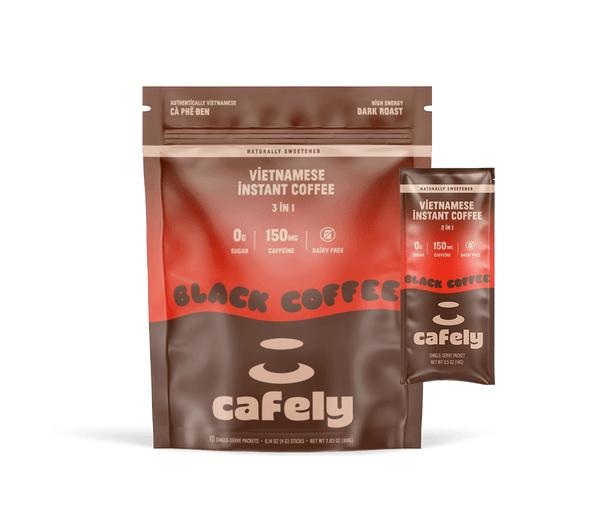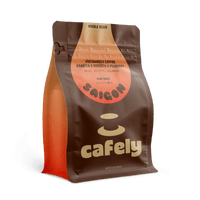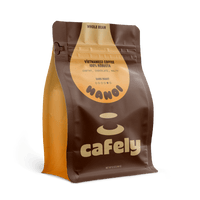Espresso is so much more than just a method of brewing coffee — it’s an art form.
An espresso machine forces a small amount of almost boiling water through finely ground and compacted coffee grounds. This technique extracts all the flavorful and aromatic elements but leaves the bitter elements behind.
The result is a thick, dark, rich coffee with a layer of creamy foam on top called the crema.
Espresso is the foundation for a wide variety of classic coffee drinks, including lattes, cappuccinos, macchiatos, Americanos, and more.
Espresso Brewing Specs
- Brew Time: 25-30 seconds
- Coffee/Water Ratio: 1:2
- Grind: Fine (like powdered sugar)
- Water Temperature: 200°F (93°C)
- Recommended Coffee: A high-quality, freshly roasted espresso blend
Espresso Brewing Summary
- Warm up your espresso machine
- Measure & grind your coffee
- Prepare & tamp your portafilter
- Brew your espresso
- Evaluate your shot. Dial & pour another one if needed
- Froth/steam your milk, & sweeten to taste
Tools You’ll Need
To brew coffee using an espresso machine, you’ll need the following items/ingredients:
- Espresso Machine — Available in all sizes and prices. Choose from manual, semi-automatic, or fully automatic.
- Tamper — A small press used to press the coffee grounds evenly into the portafilter.
- Milk Steamer (Optional) — If you enjoy milk-based espresso drinks like lattes or cappuccinos, a milk steamer is essential for frothing milk to a smooth and creamy texture.
- High-Quality Coffee — Freshly roasted beans are preferred for the fullest flavor. For espresso, a blend or single-origin that is known for its depth and complexity works best.
- Coffee Grinder — A burr grinder is highly recommended for this brewing style. The consistency of the grind makes a big difference. Aim for a fine grind like powdered sugar.
- Water — For espresso brewing, it's crucial to use fresh, filtered water to ensure the best possible flavor extraction. The quality of water can significantly affect the taste of your espresso, as it makes up a large portion of the final drink.
Step-By-Step Instructions: Espresso Machine
Here’s a simple process for brewing coffee using an espresso machine. Keep in mind every machine is a little bit different, so follow the specific instructions that come with your device.
Step 1: Warm Up Your Espresso Machine

Start by turning on your espresso machine to heat it up. Most machines take at least 15-30 minutes to properly warm up.
Always use cool, filtered water in your espresso machine reservoir. Hard water can cause a buildup of mineral deposits and lead to damage to the device over time.
Step 2: Measure & Grind the Coffee

Weigh out about 18 grams of coffee beans for a double shot or 9 grams for a single shot.
Grind your beans to a fine consistency. It should feel like powdered sugar between your fingers.
Step 3: Prepare the Portafilter

Add your ground coffee directly to the portafilter and tamp it down with your tamper. Apply even, firm pressure. Aim for consistent pressure to achieve an even extraction.
Step 4: Brew Your Espresso

Lock the portafilter onto the group head of your machine. Start the shot and time the extraction, aiming for 25-30 seconds. Look for a steady stream that resembles warm honey.
Step 5: Evaluate Your Shot

Look for a rich, creamy crema on top of your espresso. Taste your shot — it should be strong but not bitter or sour. Adjust your grind size, tamping pressure, or extraction time as needed.
You may need to calibrate your espresso machine every once in a while by pouring a shot, tasting it, then adjusting the water temperature, pressure, or grind size.
Step 6: Froth Your Milk (Optional)

For milk-based drinks, use the included milk steamer or a third-party frother to steam and froth the milk to the desired texture and temperature:
- For cappuccinos — aim for a rich, creamy froth with visible microfoam. This will typically require steaming the milk until it expands to about double its original volume. Allow for a 1:1:1 ratio of espresso, steamed milk, and milk foam.
- For lattes — focus on creating smooth, silky steamed milk with just a thin layer of microfoam on top. Lattes have a higher ratio of steamed milk to espresso, usually around 3:1, meaning you'll want to steam the milk with less air incorporation than for a cappuccino, aiming for a texture that can be poured into the espresso with minimal foam separation.
- For macchiatos — steam a small amount of milk until it's frothy, then spoon just a dollop of foam on top of the espresso. A traditional macchiato is an espresso "stained" with a small amount of milk, so the focus is on the espresso with just a hint of milk.
- For Americanos — skip this step entirely and add about twice as much hot water as the volume of your espresso shots. More water creates a milder coffee — less retains the bold, rich flavor of the espresso.
Expert Tips & Tricks: Espresso Coffee
Pulling the perfect espresso shot takes some practice, so be easy on yourself for the first little while. If you’re patient and observant, you can master the nuances of espresso brewing over time. It might take some trial and error to get there.
While there are definitely things you can do to maximize your chances of success, it's important to make your brewing process your own. What works for some might not work for others — so feel free to play around with the settings on your espresso machine and the grind level of your coffee.
1. Dial in Your Grinder
The grind size of your coffee is crucial for espresso. Too fine, and your shot will be over-extracted and bitter; too coarse, and it will be under-extracted and sour. Aim for a grind with a consistency similar to powdered sugar, but feel free to turn the dial up or down on your grinder until you find what works best for your machine.
A burr grinder is almost essential for high-quality espresso shots. These grinders use an abrasive surface (burrs) to produce precise and consistent grind sizes of your coffee.
2. Freshness Matters
Use freshly roasted coffee beans and grind them just before brewing. You’d be surprised how much of a difference this makes when using high-precision brewing tools like espresso. Pre-ground coffee just doesn’t cut it.
3. Temperature Control
Ensure your machine is at the correct brewing temperature. Too hot or too cold can drastically affect the taste. If your machine allows you to choose a specific temperature, opt for something in the range of between 197°F and 205°F (92°C and 96°C). Every machine is different, so play around with the temperature settings until you find what works best for your specific setup.
4. Consistent Tamping
Practice tamping with consistent pressure to ensure a flat, even surface. Over-tamping can cause over-extraction, while under-tamping can lead to under-extraction. Getting into a good habit is important so every tamp is identical. If not, every shot you pour will pull differently — some might be too bitter or acidic, others might be weak or watery.
History of the Espresso Machine
Espresso originated in Italy at the beginning of the 20th century by Angelo Moriondo and was later optimized with the removable portafilter by Luigi Bezzera.
The espresso machine was invented in an effort to brew coffee much faster than traditional methods — catering to the fast-paced lifestyle of Italian cities like Milan and Rome. Coffee shops still prefer these devices to this day for their ability to produce consistent, high-quality coffee in seconds.
The term “espresso” comes from the Italian word espressamente, which means "expressed" or "pressed out" — referring to the method of forcing hot water through coffee grounds under pressure.
Crafting the perfect espresso is a rewarding challenge that requires attention to detail and practice. With the right equipment and a lot of patience, you can enjoy the rich and complex flavors of espresso from the comfort of your home.
Tips For Choosing an Espresso Machine
Nothing illustrates the mind-blowing diversity of coffee brewing like the espresso machine. There’s a dizzying array of options to sift through when shopping for a machine, and the cost can range anywhere from $50 to $250,000.
To simplify the selection, we can break espresso machines into 3 main categories — each with their own set of pros and cons:
1. Manual Espresso Machines
These machines are the most basic design (and the cheapest). They require you to load the shot as normal, but you’ll need to heat and pour your own water. The pressure is generated manually by pulling a lever down — forcing the water through the coffee grounds and into your cup.
These systems hold true to the original Italian design and are a great option for beginners on a budget.
2. Super-Automatic Espresso Machines
Super-Automatic espresso machines do everything for you with the touch of a button. They can be used to make lattes, cappuccinos, or Americanos by simply changing the brew setting. These machines are expensive, feature-rich, and convenient — but they are a great option for people who don't want to fuss around with the complexity of pulling the perfect shot, steaming the milk, and cleaning up afterward.
The downside with super automatics is that you lose most of the ability to dial in your shot according to your specific preferences.
3. Semi-Automatic Espresso Machines
Semi-automatic machines are the most common type you'll find at coffee shops and in the kitchens of coffee enthusiasts. They offer a good blend of customization and automation — retaining automation of water temperature and pressure but allowing users to tweak aspects like grind size, tamping pressure, and extraction time to pull the perfect shot.
These machines range dramatically in price depending on what kind of features you want. You can find versions with single, double, or triple boilers, upgraded display interfaces, pre-infusion cycles, flow controllers, and single or multiple group heads.
FAQs & Troubleshooting: Espresso
1. What type of coffee grind is best for an espresso machine?
A fine grind is ideal for espresso machines. The coffee should have a consistency similar to table salt. These machines can be finicky, so getting a high-quality burr grinder that allows you to select specific grind sizes is helpful. The tamping pressure you use is also important as it determines how much space the water has to flow through the grounds.
2. How much coffee should I use per shot of espresso?
For a single shot of espresso (about 1 ounce or 30 milliliters), use 7-9 grams of coffee. For a double shot (about 2 ounces or 60 milliliters), use 14-18 grams of coffee. Adjustments may be necessary based on your espresso machine and preferences.
3. What is the ideal brewing temperature for espresso?
The ideal brewing temperature for espresso is between 195°F and 205°F (90°C to 96°C). Consistent temperature control is vital for extracting the best flavor from your coffee. Every machine is different, so it’s important to “dial it in” by altering the temperature settings slightly, brewing a shot, and altering some more as needed.
4. Why is my espresso bitter/sour?
Bitterness in espresso shots results from over-extraction, which can occur if the water temperature is too high, the coffee is ground too finely, or the brew time is too long. Sourness usually indicates under-extraction, possibly due to grinds that are too coarse, water temperature that’s too low, or brew times that are too quick.
5. How do I steam milk with an espresso machine?
To steam milk, fill a milk pitcher no more than halfway with cold milk. Submerge the steam wand just below the surface of the milk and turn on the steam. Keep the tip near the surface to incorporate air and create foam. Move the pitcher in a swirling motion to heat the milk evenly until it reaches a silky texture and the desired temperature. Ideal steam temperature typically ranges from 140°F to 160°F ( 60°C to 70°C).
6. How often should I clean my espresso machine?
You should perform a basic cleaning of the portafilter and group head after each use. Backflushing with water should be done daily if your machine is equipped for it. Chemical backflushing and deep cleaning of other components, like the steam wand and grinder, should be done according to the manufacturer's recommendations, usually every 1-2 weeks for professional machines or every month for home devices.
7. Can I use tap water in my espresso machine?
Tap water can be used, but we recommend against it. The mineral content and quality of tap water vary greatly by location and can affect the taste of your espresso as well as potentially harm your machine due to scale buildup. Filtered or bottled water with a balanced mineral content is recommended.
8. What is the difference between semi-automatic & automatic espresso machines?
Semi-automatic espresso machines require the user to manually start and stop the flow of water for brewing espresso. Automatic espresso machines automate this process, delivering a pre-set amount of water through the coffee. Super-automatic machines can also grind the coffee, tamp it, and automatically brew the espresso at the touch of a button.
9. Why does my espresso have no crema?
A lack of crema can be caused by several factors, including using coffee that is too old (freshness is key for good crema), not using enough coffee, grinding too coarsely, or applying insufficient pressure during the extraction process. Adjusting these variables can help deliver a nice crema in every shot.
